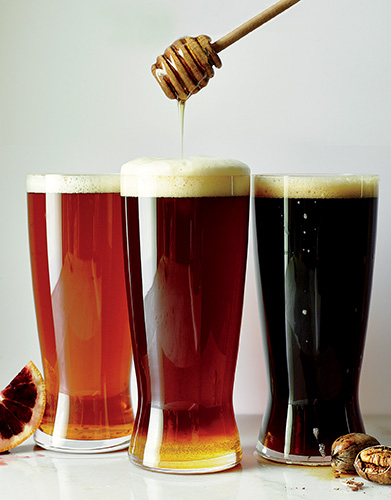Most people in the South don’t pine for persimmons, the small tart fruits that grow wild across the region. But Sean Wilson, the founder of Fullsteam brewery in Durham, North Carolina, will pay up to three dollars a pound for them to put into First Frost, a rich, stomach-warming ale with natural notes of cinnamon and apricot. He doesn’t use artificial flavors and forgoes heavy-handed seasonings like nutmeg that might typically find their way into a fall beer. “We don’t spice the beer,” Wilson says, “so we can really celebrate the flavor of this unique Southern fruit.”
As anyone who’s sipped on a pumpkin or blueberry ale can attest, produce-driven brews are hardly a novel idea. But as craft brewers continue to proliferate across the South—since 2011, the region’s annual production has more than doubled, according to the Brewers Association—more and more Southern breweries are focusing on using fresh ingredients that speak to local cuisines. For example, several producers in North Carolina, including Fullsteam and Fonta Flora, in Morganton, have started making beer with pawpaw fruit, a delicacy relatively unknown in much of the Deep South, let alone the rest of the country.
Think of this new generation of harvest beers as the boozy analogue to farm-to-table cuisine, with brewers following chefs in using all the locally sourced ingredients they can get their hands on. “We feel craft beer is very much about place, and what better way to highlight where you’re from than to feature it in your beer?” says Joleen Senter Durham, who with her husband runs Piney River Brewing Company in Bucyrus, Missouri, near the Arkansas border in the heart of the Ozarks. Piney River opened in 2011, and one of its first beers was a wheat ale made with black walnuts, a regional staple that residents call Ozark Gold. Today, the brewery also makes a roasted Sweet Potato Ale inspired by sweet potato pie.
Though agriculturally focused beer isn’t unique to the South, the link between the two has a special resonance in a region where many brewers and consumers still have strong ties to the land. “All our ancestors were agrarian,” says Karlos Knott, the president of Bayou Teche Brewing in Arnaudville, Louisiana. “And still, even in the suburbs, people have gardens and chicken coops, so it’s natural to use local ingredients.” Among Bayou Teche’s offerings is Miel Sauvage, made with honey from an apiary six miles away. It’s a smooth, barrel-aged beer tinged with vanilla and oak that pairs well with charcuterie, mild cheese, even Cajun pork cracklings.
In Boynton Beach, Florida, Mike Halker of Due South Brewing Company also uses honey from a nearby beekeeper (each batch requires more than a hundred pounds), as well as espresso from a neighboring roaster and Florida-grown oranges, moves that might be costlier up front but can pay dividends over time. “We try to be as much a part of the community as we can,” Halker says. “And it’s a circle: When I buy his honey, he makes money, and he goes to a restaurant and maybe buys one of my beers.”
Reflecting regional food cultures can also help a new brewery bring in customers. “One of the best and most creative ways to entice people to try our beer,” says Leslie Henderson of Lazy Magnolia in Kiln, Mississippi, whose ten-year-old brewery was one of the first in the state, “was to incorporate well-known ingredients that would get people to look at it and go, ‘Beer is kind of like food. There might be some connection to my life.’” One of the brewery’s latest beers, called 10, is a robust Belgian-style ale that marries fragrant Mississippi pecans with notes of figs, plums, and caramel malts.
Of course, relying on locally grown, occasionally foraged ingredients means ceding some control to Mother Nature, Fullsteam’s Wilson says. “One of the challenges is working with the harvest cycle.” If there’s a particularly rainy, dry, or short growing season, his beers will taste a little different, and he might not have enough to meet demand, which might in turn leave him with some frustrated customers. But even that is worth it, he says, to reinforce the notion that in the South, craft beer is increasingly a farmed, not manufactured, product.
“When people close their eyes,” Wilson says, “I would love for them to picture the local farmers growing and harvesting the products that make their beer unique.”








